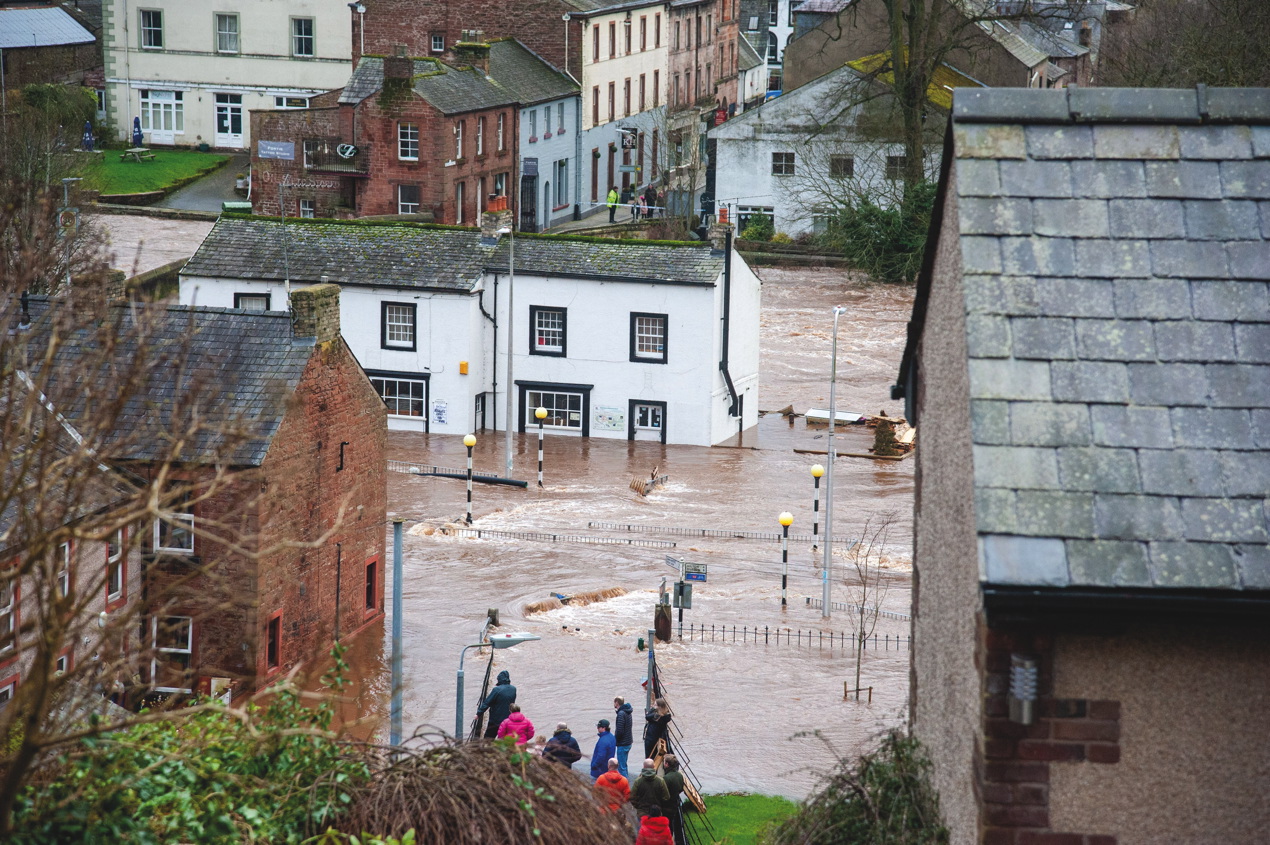In self defence
Lack of funding as well as coronavirus is delaying much needed flood defence work in Cumbria, forcing residents to take matters into their own hands
With the combination of coronavirus and the onset of spring, for some of us the rain-sodden days of early February may seem like a distant memory.
However, for those whose homes and livelihoods were affected by the flooding that accompanied Storm Ciara on the weekend of 8-9 February it is an issue that is never far from their minds.
“Since Storm Desmond the Environment Agency hasn’t made any improvements to flood defences.”
This is especially true in a county like Cumbria, which has experienced major flooding in 2005, 2009 and 2015 and where residents live in the knowledge that climate change is only going to increase the frequency of extreme weather events.
During Storm Ciara residents watched in trepidation as river levels rose in a way that was all too reminiscent of Storm Desmond in December 2015, which caused widespread damage across the county.
Train services were cancelled or reduced, flights from Carlisle Lake District Airport were grounded and more than 25,000 properties lost power.
Since 2009, more than £55 million has been spent on building flood defences across Cumbria.
The Environment Agency says investment since 2015 has significantly reduced flood risk to more than 9,000 properties.
However, many in the county are still asking why, after so much work, sandbags, flood alerts, insurance claims and clean-up operations are becoming such grimly familiar features of living in Cumbria in winter.
Probably the worst hit community in February was Appleby-in-Westmorland.
Patrick Leach, 63, has lived in the town for 46 years and runs Capstick Carpets – just a few metres from the River Eden.
Since the shop was flooded during Storm Desmond he has invested thousands in protecting the business.
“I have built my own flood barriers because the Environment Agency don’t have any funds to do anything in Appleby,” he says.
“Since Storm Desmond they haven’t made any improvements or alterations to any of the flood defences.”
He says flood defences had been built in the past, but these are on the opposite side of the river to his property.
“That has just made our side worse,” says Leach.
He has spent much of the last five years putting in place his own flood defence system to protect his shop and three adjoining properties, costing a total of around £40,000.

“All the building work took about six weeks and the planning permission took two years,” he says.
“I came up with the concept and we got a couple of local companies to come on board and they did the structural engineering.”
This, combined with pumping the water away with petrol-driven pumps, allowed him to avoid serious damage and re-open the day after the worst of the floodwater hit in February.
The Environment Agency says there is a “scheme in development” to reduce the effects of flooding in Appleby.
The main objective of this is to reduce the risk of flooding from Doomgate Beck, one of the main tributaries of the River Eden.
This is likely to involve installing a pumping station to allow it to discharge water into the River Eden even when it is high and reduce the flooding risk to nearby areas.
Work is also planned to carry out culvert improvement works upstream to increase the amount of water that can be discharged and reduce the risk in that area.
An Environment Agency spokesperson says: “Unfortunately, other elements of the scheme which were being appraised, for example, the proposed raising of the existing town centre defences and construction of flood defences on the Sands, are no longer affordable options and cannot be progressed further without significant additional funding.
“The Environment Agency is supporting communities that do not have completed or permanent flood defences and remain at risk of flooding. We are doing this in many ways, from forecasting potential flood risk and warning communities to utilising mobile high-volume pumps. In Appleby, our operational teams have been very active within the area removing both debris and blockages on a consistent maintenance schedule.”
At the same time as worrying about future flooding, some in Cumbria are still living with the very real effects of Storm Desmond five years ago.
In Pooley Bridge, at the northern tip of Ullswater, a permanent replacement is being built for the original 18th century bridge, which was washed away during the storm.
Estimated to have a final cost of £5 million, the new bridge over the River Eamont was tipped to open to traffic this spring but is currently only open to foot traffic.
The five year wait for people and businesses in the village is only being added to after contractors were forced to down tools by the coronavirus outbreak.
Andrew Kaye, who owns the shop Chestnut House, which sells a range of local produce in Pooley Bridge, says the closure has definitely had an effect on business.
The business is running a delivery service during the coronavirus lockdown, but has been forced to take barrowloads of deliveries across the river by hand as it is quicker than driving.
“It’s going to be fantastic when it’s done and it will be a real feature. We are very positive and hopeful,” says Kaye.
Following the damage caused by Storm Desmond, Cumbria received approximately £120 million from the government for repairs.
Keith Little, Cumbria County Council’s cabinet member for highways and transport, says it has been spending the money at a rate of roughly £30 million a year and expects to have used it all by the end of this year.
Although the Pooley Bridge project had been delayed, Little hopes it could be completed by the end of June. It is likely the work could begin again as long as contractors maintain social distancing rules and wear protective equipment to guard against infection, he says.
Work to develop flood mitigation for towns and villages across the county is still underway.
The size of the county, combined with the time and resources required to do the work, means it’s a time-consuming process, says Little.
Another issue was that as rivers ran into the sea, the risk of flooding was exacerbated by the state of the tide and the silt which built up annually due to coastal erosion.
Much of the work to reduce the risk to built-up areas is focused on directing water to flow off the land via rivers that avoid communities, or on allowing land upstream to flood so the water can then dissipate more slowly.
“If you are asking me if we get a serious winter in 2020-21 are we going to be safe I can’t guarantee nobody will be flooded again,” says Little.
Unfortunately, these words are only echoed by the Environment Agency.
“It is not always possible to build defences big enough to protect every home or business, and even with new flood defences in place, people cannot ever be fully protected from flooding,” says its spokesperson.
“We know a long term view is needed as climate change will lead to more frequent bouts of extreme weather, including heavy rainfall which causes flooding.”

Leave a reply
Your email address will not be published.